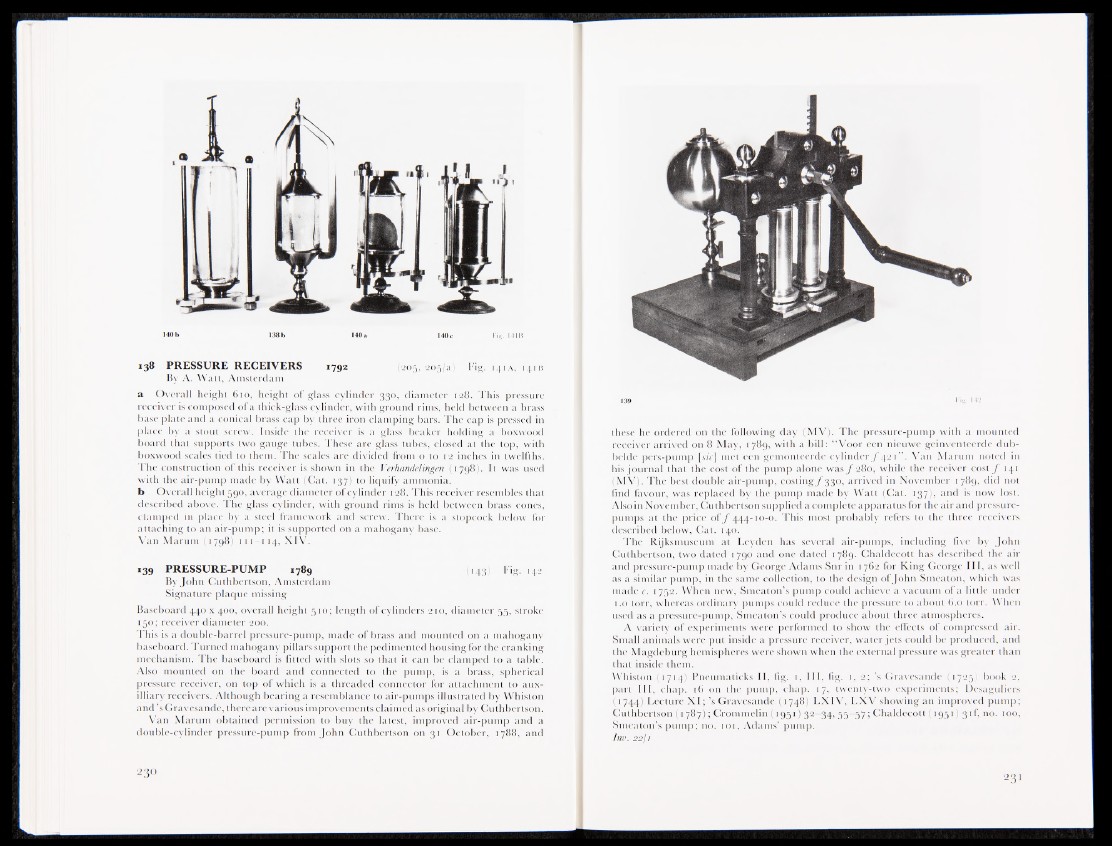
a A
138 PRESSURE RECEIVERS 1792 (205, 205/a) Fig. i4ia, 141 b
By A. Watt, Amsterdam
a Overall height 610, height of glass cylinder 330, diameter 128. This pressure
receiver is composed of a thick-glass cylinder, with ground rims, held between a brass
base plate and a conical brass cap by three iron clamping bars. The cap is pressed in
place by a stout screw. Inside the receiver is a glass bt'aker holding a boxwood
board that supports two gauge tubes. These are glass tubes, closed at the top, with
boxwood scales tied to them. The scales are divided from 0 to 12 inches in twelfths.
The construction of this receiver is shown in the Verhandelingen (1798). It was used
with the air-pump made by Watt (Cat. 137) to liquify ammonia,
b Overall height 590, average diameter of cylinder 128. This receiver resembles that
described above. The glass cylinder, with ground rims is held between brass cones,
clamped in place by a steel framework and screw. There is a stopcock below for
attaching to an air-pump; it is supported on a mahogany base.
Van Marum (1798) 111-114, XIV.
139 PRESSURE-PUMP 1789 (143) Fig. 142
By John Cuthbertson, Amsterdam
Signature plaque missing
Baseboard 440 x 400, overall height 510; length of cylinders 210, diameter 55, stroke
150; receiver diameter 200.
This is a double-barrel pressure-pump, made of brass and mounted on a mahogany
baseboard. Turned mahogany pillars support the pedimented housing for the cranking
mechanism. The baseboard is fitted with slots so that it can be clamped to a table.
Also mounted on the board and connected to the pump, is a brass, spherical
pressure receiver, on top of which is a threaded connector for attachmenSto aux-
illiary receivers. Although bearing a resemblance to air-pumps illustrated by Whiston
and’s Gravesande, there are various improvements claimed as original by Cuthbertson.
Van Marum obtained permission to buy the latest, improved air-pump and a
double-cylinder pressure-pump from John Cuthbertson on 31 October, 1788, and
139 H 142
these he ordered on the following day (MV). The pressure-pump with a mounted
receiver arrived on 8 May, 1789, with a bill: “Voor een nieuwe geinventeerde dub-
belde pers-pump [sic] met een gemonteerde cylinder j 421” . Van Marum noted in
his journal that the cost of the pump alone was ƒ 280, while the receiver cost f 141
(MV). The best double air-pump, costing ƒ 330, arrived in November 1789, did not
find favour, was replaced by the pump made by Watt (Cat. 137)7'and Is now lost.
Also in November, Cuthbertson supplied a complete apparatus for the air and pressure-
pumps at the price ofy^ 444-10-0. This most probably refers to the three receivers
described below, Cat. 140.
The Rijksmuseum at Leyden has several air-pumps, including five by John
Cuthbertson, two dated 1790 and one dated 1789. Chaldecott has described the air
and pressure-pump made by George Adams Snr in 1762 for King George III, as well
as a similar pump, in the same collection, to the design of John Smeaton, which was
made c. 1752. When new, Smeaton’s pump could achieve a vacuum of a little under
t .0 torr, whereas ordinary pumps could reduce the pressure to about 6.0 torr. When
used as a pressure-pump, Smeaton’s could produce about three atmospheres.
A variety of experiments were performed to show the effects of compressed air.
Small animals were put inside a pressure receiver, water jets could be produced, and
the Magdeburg hemispheres were shown when the external pressure was greater than
that inside them.
Whiston (,1714) Pneumaticks II, fig. 1, III, fig. 1, 2; ’s Gravesande (1725) book 2,
part III, chap. 16 on the pump, chap. 17, twenty-two experiments; Desaguliers
(1744) Lecture XI; ’s Gravesande (1748) LXIV, LXV showing an improved pump;
Cuthbertson (1787); Crommclin (1951) 32—34, 55—57 > Chaldecott (1951) 31 f, no. 100,
Smeaton’s pump; no. 101, Adams’ pump.
Inv. 22jl